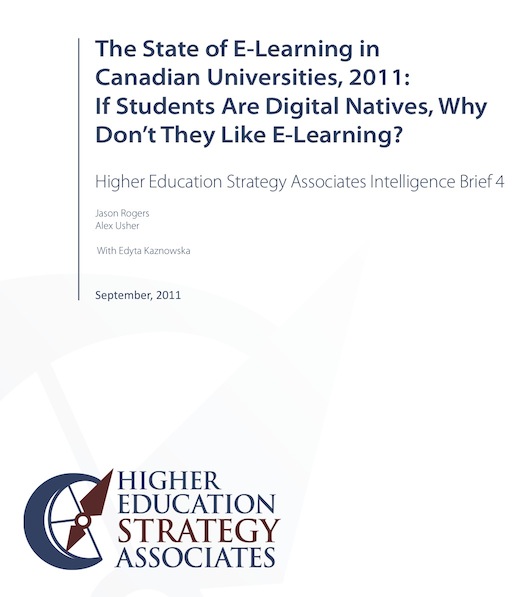Here’s the key fact you need to know about HESA’s new report on the State of E-learning in Canada: as the intensity of availability of e-learning resources increase, students become less satisfied, and less likely to say they feel they are learning a lot.
 Contrary to the rantings of technophiles, students don’t behave much like “digital natives.” They still far prefer to do their readings on paper rather than on a screen, for instance. They really don’t seem to have a lot of time for dynamic e-learning resources like interactive discussion forums, and they don’t think there is any comparison between courses you take in person and those you watch even occasionally on a screen – the former wins hands down.
Contrary to the rantings of technophiles, students don’t behave much like “digital natives.” They still far prefer to do their readings on paper rather than on a screen, for instance. They really don’t seem to have a lot of time for dynamic e-learning resources like interactive discussion forums, and they don’t think there is any comparison between courses you take in person and those you watch even occasionally on a screen – the former wins hands down.
The fact is, Canadian students aren’t impressed by the e-learning resources on offer in Canadian universities. Now, possibly that’s because they don’t like e-learning, period. Particularly in the humanities, there’s an aura of eros around the teacher-as-guru that e-learning enthusiasts just don’t seem to take into account.
But possibly we just aren’t getting the implementation right. It might just be that the technology, and the way in which we integrate it with the curriculum, just isn’t that good. Just because students aren’t digital natives doesn’t mean universities can’t underwhelm them.
For the moment, students pretty clearly see e-learning resources as a convenience issue. What they seem to want is as much course-related text as possible available online all the time so that missing class is less of a big deal. But that suggests it’s an alternative to in-class learning, not an addition to it.
Work done by the National Center for Academic Transformation has shown how intelligent course redesign can improve learning outcomes and reduce costs, and with budget crises looming across much of the country, this isn’t something any institution can sensibly ignore. But it will require institutions to pay a lot more attention to implementation and to continually measure and monitor results to find out what works and what doesn’t.
That’s a big task, but it’s one HESA will be working on for years to come.
Extra note: those of you in Ontario looking for deeper commentary on the Liberals’ Big Idea regarding tuition grants, visit my Globe and Mail blog.

 Tweet this post
Tweet this post

We agree> In a critique in so far as to how the technology is applied, the idea of replacing the “teacher-as-guru” just doesn’t fly. And in the current economic crisis it is apparent that the motive for a shift to online learning via posted text modules is economic and not altruistic.
However, as a provider of online services we do believe in the medium, and we have had great success with it at the secondary educaiton level. Our online courses are hosted by a state certified content specialist. Our goal is not to change the method of content delivery but rather to mirror it in a virtual medium. That the relationship between novice and scholar is preserved and that students have as much chance to interact with their peers in the virtual environment as they do in a brick and mrotar setting. In this way the virtual medium can be applied to and enhance current academic offerings.
We have applied this format to home instruction (where studetns are not able to attend, remedial, and in school and after school full course offeirngs. Students from different districts from around the state participate providing a greater dynamic in the classroom experience. The openness of the virtual context allows the moderator to bring in experts or guest lecturers who would not normally be available. This is where those wishing to use this new medium will find their success.
The academic professional cannot be replaced in this new equation. But this new equation will give that professional a wider platform with greater reach and more potential. Our imaginations are the only limit on this brand new vista. Unless of course we relegate it to just posting text modules online, then that in itself will stifle any creativity.
Much Kind Regards,
Fred De Sena VP Innovaitons in Onlien Education, Inc.